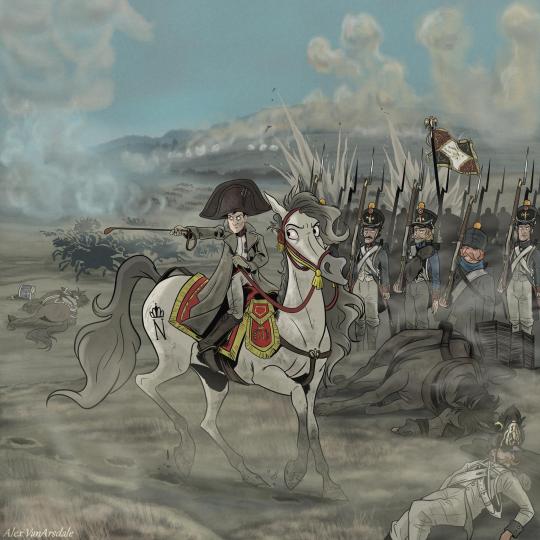#FirstFrenchEmpire
Explore tagged Tumblr posts
Photo

Napoleon Bonaparte
Napoleon Bonaparte (1769-1821) was a Corsican-born French general and politician who reigned as Emperor of the French with the regnal name Napoleon I from 1804 to 1814 and then again briefly in 1815. He established the largest continental European empire since Charlemagne and brought liberal reforms to the lands he conquered at the cost of the destructive Napoleonic Wars (1803-1815).
Continue reading...
171 notes
·
View notes
Photo

Today is the 214th anniversary of the battle of Austerlitz! One of Napoleon's greatest victories. The battle of the three Emperors showed Europe that the French Emperor was not to be trifled with. I'm quite happy with this piece! Napoleon is in the heat of it here as he commands the fusiliers to advance. Meanwhile the elite cavalry of both armies charge each other head on in the background!
#alex#austerlitz#Battle of Austerlitz#Marengo#horse#battle#battleofthethreeemperors#cannons#frenchempire#firstfrenchempire#jacqueandcheval#france#First French Empire#Jacque and Cheval#Battle of the three emperors#equestrian#equine#war#fusiliers
52 notes
·
View notes
Photo

Napoleon Bonaparte
Napoleon Bonaparte (1769-1821) was a Corsican-born French general and politician who reigned as Emperor of the French with the regnal name Napoleon I from 1804 to 1814 and then again briefly in 1815. He established the largest continental European empire since Charlemagne and brought liberal reforms to the lands he conquered at the cost of the destructive Napoleonic Wars (1803-1815).
Continue reading...
65 notes
·
View notes
Photo

Joséphine de Beauharnais
Joséphine de Beauharnais (1763-1814) was a French noblewoman who was the first wife of Napoleon Bonaparte (1769-1821). She was therefore Empress of the French from 18 May 1804 until the annulment of her marriage on 10 January 1810, as well as Queen of Italy from March 1805 until 1810.
Continue reading...
76 notes
·
View notes
Photo

Napoleon's Invasion of Russia
Napoleon's invasion of Russia, also known as the Second Polish War or, in Russia, as the Patriotic War of 1812, was a campaign undertaken by French Emperor Napoleon I (r. 1804-1814; 1815) and his 615,000-man Grande Armée against the Russian Empire. It was a catastrophic defeat for Napoleon and one of history's deadliest military operations, causing approximately 1,000,000 total deaths.
Continue reading...
137 notes
·
View notes
Photo

17 Campaigns & Battles of Napoleon
Napoleon Bonaparte (1769-1821), Emperor of the French, was one of the most successful military commanders of the modern era. From relatively humble beginnings, he rose to prominence during the tumultuous wars of the French Revolution, ultimately fighting in over 60 battles, of which he lost only seven. His conquests expanded his empire to the borders of Europe.
Continue reading...
40 notes
·
View notes
Photo

Battle of Leipzig
The Battle of Leipzig (16-19 October 1813), or the Battle of the Nations, was the largest battle of the Napoleonic Wars (1803-1815), featuring over half a million soldiers and resulting in over 100,000 total casualties. The climax of the 1813 German campaign, the battle ended with the decisive defeat of French Emperor Napoleon I (r. 1804-1814; 1815).
Continue reading...
43 notes
·
View notes
Photo

Coronation of Napoleon I
The Coronation of Napoleon I as Emperor of the French took place on Sunday 2 December 1804, in the Notre-Dame de Paris cathedral. A sacred ceremony held to legitimize Napoleon's reign, the coronation signaled the birth of the First French Empire (1804-1814; 1815) and established the imperial Bonaparte Dynasty.
Continue reading...
47 notes
·
View notes
Photo

Coronation of Napoleon I
The Coronation of Napoleon I as Emperor of the French took place on Sunday 2 December 1804, in the Notre-Dame de Paris cathedral. A sacred ceremony held to legitimize Napoleon's reign, the coronation signaled the birth of the First French Empire (1804-1814; 1815) and established the imperial Bonaparte Dynasty.
Continue reading...
32 notes
·
View notes
Photo

Battle of Austerlitz
The Battle of Austerlitz (2 December 1805), or the Battle of the Three Emperors, was one of the most significant battles of the Napoleonic Wars (1803-1815). It saw French Emperor Napoleon I (r. 1804-1814; 1815) and his Grande Armée decisively defeat a larger Austro-Russian army. Napoleon's victory affirmed French military hegemony in continental Europe for most of the next decade.
Continue reading...
38 notes
·
View notes
Photo

War of the Third Coalition
The War of the Third Coalition (1805-1806) was a major European conflict during the Napoleonic Wars (1803-1815). It was fought by an alliance of nations that included the United Kingdom, Russia, Austria, Sweden, Naples, and Sicily, against the First French Empire of Napoleon I (r. 1804-1814; 1815), its client states, and its reluctant ally of Spain.
Continue reading...
26 notes
·
View notes
Photo

Ulm Campaign
The Ulm Campaign (25 September to 20 October 1805) was a military operation during the War of the Third Coalition (1805-1806). Through a series of maneuvers, the 210,000 men of the French Grande Armée, led by Emperor Napoleon I, encircled an Austrian army under General Karl Mack von Leiberich in the city of Ulm. The Austrians capitulated on 20 October.
Continue reading...
22 notes
·
View notes
Photo

The First French Empire under Napoleon I, 1812
A map illustrating the rise and apogee of the First French Empire, the dominant force in the European continent between 1804 and 1814 (and briefly for Hundred Days in 1815) under Napoleon Bonaparte. The Napoleonic Wars established French military hegemony in Europe in the early 19th century as far as Poland and southern Italy and delivered sweeping french victories, spectacular defeats, restoration of the monarchy, followed by a second republic, a second empire, and then a third republic in the nineteenth century alone.
48 notes
·
View notes